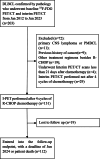Prognostic value of interim PET/CT in GCB and non-GCB DLBCL: comparison of the Deauville five-point scale and the ΔSUVmax method
- PMID: 39731077
- PMCID: PMC11681756
- DOI: 10.1186/s12885-024-13360-w
Prognostic value of interim PET/CT in GCB and non-GCB DLBCL: comparison of the Deauville five-point scale and the ΔSUVmax method
Abstract
Background: This study aimed to identify the prognostic value of interim 18F-FDG PET/CT (I-PET) for germinal center B-cell-like (GCB) and non-GCB diffuse large B-cell lymphoma (DLBCL), respectively.
Methods: Baseline 18F-FDG PET/CT (B-PET) and I-PET scans were performed in 112 patients with DLBCL. The prognostic value of I-PET using the Deauville five-point scale (D-5PS) criteria or percentage decrease in SUVmax (∆SUVmax) for GCB and non-GCB DLBCL were evaluated.
Results: A significant difference in progression-free survival (PFS) was found between GCB and non-GCB DLBCL patients (P < 0.05). Based on D-5PS criteria, I-PET was divided into positive (score > 3) and negative (score ≤ 3) subgroups. Results indicated that I-PET using D-5PS criteria was an independent predictor for PFS of GCB DLBCL (P < 0.05), but not for overall survival (OS) (P > 0.05). For non-GCB DLBCL, PFS and OS were significantly higher in I-PET negative group than I-PET positive group (P < 0.05). Receiver operating characteristic (ROC) curve analysis proved that I-PET using ΔSUVmax can also effectively predict PFS and OS of non-GCB DLBCL (P < 0.05), but not for GCB DLBCL (P > 0.05). Based on the optimal threshold found by ROC curve analysis, patients were dichotomized into ∆SUVmax high and low groups. Log-rank test and Cox regression demonstrated that the layered ∆SUVmax was predictive of PFS and OS in non-GCB DLBCL (P < 0.05).
Conclusions: I-PET may have different prognostic values for GCB and non-GCB DLBCL. Thus, the pathology type of DLBCL may be considered while using I-PET as a prognostic tool in the future.
Keywords: DLBCL; GCB; Non-GCB; PET/CT; R-CHOP.
© 2024. The Author(s).
Conflict of interest statement
Declarations. Ethics approval and consent to participate: The data collection and the methods used in this study were carried out in accordance with the ethical standards of the institutional and national research committee and with the 1964 Helsinki Declaration and its later amendments or comparable ethical standards. The data collection program for this study was approved by Shanghai General Hospital Research Ethics Committee (No.2024064) with a waiver for individual informed consent for this retrospective study. Consent for publication: Not applicable. Competing interests: The authors declare no competing interests.
Figures





Similar articles
-
Different predictive values of interim 18F-FDG PET/CT in germinal center like and non-germinal center like diffuse large B-cell lymphoma.Ann Nucl Med. 2017 Jan;31(1):1-11. doi: 10.1007/s12149-016-1123-6. Epub 2016 Sep 15. Ann Nucl Med. 2017. PMID: 27627889
-
Prognostic analysis of interim 18F-FDG PET/CT in patients with diffuse large B cell lymphoma after one cycle versus two cycles of chemotherapy.Eur J Nucl Med Mol Imaging. 2019 Feb;46(2):478-488. doi: 10.1007/s00259-018-4198-6. Epub 2018 Oct 31. Eur J Nucl Med Mol Imaging. 2019. PMID: 30382301 Free PMC article.
-
Metabolic tumour area: a novel prognostic indicator based on 18F-FDG PET/CT in patients with diffuse large B-cell lymphoma in the R-CHOP era.BMC Cancer. 2024 Jul 25;24(1):895. doi: 10.1186/s12885-024-12668-x. BMC Cancer. 2024. PMID: 39054508 Free PMC article.
-
Predictive value of F-18 FDG PET/CT quantization parameters in diffuse large B cell lymphoma: a meta-analysis with 702 participants.Med Oncol. 2015 Jan;32(1):446. doi: 10.1007/s12032-014-0446-1. Epub 2014 Dec 16. Med Oncol. 2015. PMID: 25511321
-
Clinical scoring systems, molecular subtypes and baseline [18F]FDG PET/CT image analysis for prognosis of diffuse large B-cell lymphoma.Cancer Imaging. 2024 Dec 18;24(1):168. doi: 10.1186/s40644-024-00810-8. Cancer Imaging. 2024. PMID: 39696503 Free PMC article. Review.
Cited by
-
Interim PET after 4 cycles predicts outcome in histomolecularly confirmed primary mediastinal B-cell lymphoma.Blood Adv. 2025 May 13;9(9):2232-2246. doi: 10.1182/bloodadvances.2024015577. Blood Adv. 2025. PMID: 40030008 Free PMC article. Clinical Trial.
References
-
- Siegel RL, Miller KD, Wagle NS, Jemal A. Cancer statistics, 2023. CA Cancer J Clin. 2023;73(1):17–48. - PubMed
-
- Logue JM, Chavez JC. How to sequence therapies in diffuse large B-Cell lymphoma Post-CAR-T cell failure. Curr Treat Options Oncol. 2021;22(12):112. - PubMed
-
- Hans CP, Weisenburger DD, Greiner TC, Gascoyne RD, Delabie J, Ott G, et al. Confirmation of the molecular classification of diffuse large B-cell lymphoma by immunohistochemistry using a tissue microarray. Blood. 2004;103(1):275–82. - PubMed
Publication types
MeSH terms
Substances
Grants and funding
LinkOut - more resources
Full Text Sources
Research Materials

